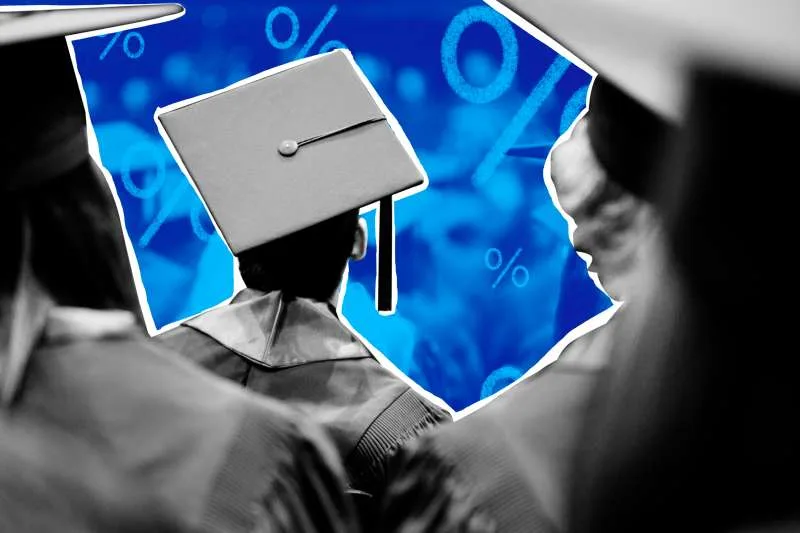Are Student Loan Rates High Right Now? Discover the Truth Behind the Numbers
Yes, student loan rates are currently high, making it costly for borrowers to finance their education. In recent years, student loan interest rates have been soaring, burdening countless borrowers with hefty monthly payments.
The rising cost of education coupled with high loan rates has created a challenging financial landscape for students and graduates alike. With interest rates on the rise, it becomes increasingly difficult for students to repay their loans and secure a stable financial future.
Many students are left grappling with the choice between pursuing higher education and shouldering the burden of substantial debt. This situation emphasizes the need for careful financial planning and exploring alternative options to minimize the impact of high student loan rates.
:max_bytes(150000):strip_icc()/compoundinterest_final-5c67da5662ba458f8d9d229ab4ca4292.png)
Credit: www.investopedia.com
The Current State Of Student Loan Rates
Student loan rates have always been a hot topic of discussion, especially among aspiring college students and graduates. Many students are burdened with the question, “Are student loan rates high right now?” To answer this question, let’s delve into the current state of student loan rates by examining the factors affecting these rates and exploring the historical trends.
Factors Affecting Student Loan Rates
Several factors influence student loan rates, making it essential to understand how these elements can impact the interest borrowers pay. The following are some key factors:
- Economic conditions: The overall state of the economy plays a significant role in determining student loan rates. When the economy is thriving, interest rates tend to rise, and vice versa.
- Government policy: Government policies and legislation can directly affect student loan rates. Changes in regulations or federal interventions can lead to fluctuations in interest rates.
- Borrower creditworthiness: Just like any other type of loan, student loan rates depend on the borrower’s creditworthiness. A good credit score and income stability can help secure lower interest rates.
- Type of loan: Different types of student loans, such as federal and private loans, may have varying interest rates. It’s crucial to understand the terms and conditions of the loan to determine the associated interest rate.
Historical Trends In Student Loan Rates
To gauge the current state of student loan rates accurately, it is essential to examine historical trends. Understanding how rates have evolved over time can provide valuable insights. Here are a few notable trends:
- In the past decade, student loan rates have experienced fluctuations due to changes in government policies and economic conditions.
- Between 2010 and 2013, rates for federally subsidized Stafford loans increased due to the expiration of the College Cost Reduction and Access Act, resulting in higher interest payments.
- In recent years, there has been a downward trend in student loan rates due to the Federal Reserve’s decision to lower interest rates, aiming to stimulate the economy.
It is crucial to stay updated with the latest news and changes in student loan rates to make informed decisions and plan for repayment. By considering all the factors mentioned and understanding historical trends, borrowers can assess the current state of student loan rates and make decisions accordingly.
Comparing Student Loan Rates To Other Borrowing Options
Comparing student loan rates to other borrowing options helps determine if student loan rates are high right now. Understanding the current interest rates for student loans in comparison to other borrowing options can help students make informed decisions about financing their education.
It is essential to evaluate the rates carefully to minimize the financial burden of student loans.
When searching for the best way to finance your education, it’s essential to consider the interest rates for different borrowing options. Student loan rates are often a topic of concern for many borrowers, especially when compared to other types of loans such as mortgages and auto loans.
Interest Rates For Mortgages
Mortgage loans are long-term loans designed to help individuals purchase homes. These loans usually have lower interest rates compared to student loans because they are secured by collateral, which is typically the property being financed. With interest rates averaging around X.X%, mortgage loans tend to be more favorable for borrowers in terms of overall costs compared to high student loan rates.
Interest Rates For Auto Loans
Auto loans are loans specifically tailored to finance the purchase of a vehicle. These loans also tend to have lower interest rates compared to student loans due to the collateral involved, which is the vehicle being financed. The average interest rate for auto loans is currently around X.X%, making them another borrowing option with lower rates than student loans.
Comparing student loan rates to interest rates for mortgages and auto loans reveals a stark contrast in affordability. Student loans, unfortunately, have higher interest rates, making them a less favorable borrowing option in terms of interest costs. The average interest rate for student loans is roughly X.X%, significantly higher than mortgages and auto loans.
Considering these differences, it’s crucial for students and families to carefully evaluate their loan options. While student loans are often necessary to pursue higher education, it’s essential to be aware of the potential long-term financial implications. Exploring alternatives, such as scholarships, grants, and work-study programs, can help minimize the need for student loans and mitigate the impact of high interest rates.
Ultimately, being knowledgeable about interest rates and comparing them to other borrowing options is a crucial step in making an informed decision about financing your education. While student loan rates may be high, exploring all available options and planning ahead can help manage the burden of student loan debt in the long run.
Government Initiatives And Student Loan Rates
Federal Student Loan Interest Rates
“` The federal government plays a crucial role in determining the interest rates for student loans. These rates are set annually based on the yield of the 10-year Treasury note. <strong>Federal student loan interest rates</strong> are fixed, meaning they remain the same throughout the life of the loan. For undergraduate direct subsidized and unsubsidized loans disbursed between July 1, 2021, and July 1, 2022, the interest rate stands at 3.73%. For graduate direct unsubsidized loans, the rate is 5.28%, and for parent and graduate PLUS loans, it is 6.28%. Effect of Policy Changes on Student Loan Rates “`htmlEffect Of Policy Changes On Student Loan Rates
“` Policy changes introduced by the government can significantly impact student loan rates. For example, the CARES Act, enacted in response to the COVID-19 pandemic, temporarily set the interest rate for federal student loans at 0% and suspended payments from March 13, 2020, to September 30, 2021. These initiatives provided relief to borrowers during a challenging period. Additionally, the recent discussions around potential student loan forgiveness and interest rate reduction have raised anticipation and speculation among borrowers regarding future changes in loan terms. By staying informed about federal initiatives and policy changes, borrowers can make informed decisions regarding their student loans. Understanding the impact of government decisions on student loan rates is crucial for managing and planning for educational debt effectively.
Credit: www.foxbusiness.com
The Impact Of High Student Loan Rates
High student loan rates have far-reaching consequences, affecting not only individual graduates but also the broader economy. The financial burden placed on graduates can be overwhelming, hindering their ability to save, invest, and contribute to long-term economic growth. Additionally, the economic implications of high student loan rates can slow down consumer spending, limit job mobility, and curtail entrepreneurship. Let’s explore these impacts further.
Financial Burden On Graduates
The exorbitant rates of student loans have become a significant financial burden on countless graduates. With limited job prospects and stagnant wage growth, many find themselves struggling to make ends meet while simultaneously servicing their student debt. The weight of loan repayments can hinder their ability to save for essential expenses such as housing, healthcare, and retirement.
The burden of student loans becomes particularly challenging for young professionals who are at a stage in their lives where they are often starting families, building homes, and making important long-term financial decisions. The sheer magnitude of student loan payments can restrict their ability to become homeowners, delay marriage, or inevitably lead to higher levels of stress and mental health issues.
Economic Implications
The impact of high student loan rates extends beyond individual graduates, impacting the overall economy as well. When graduates are burdened by significant debt, they are less likely to spend money on consumer goods and services, effectively reducing consumer spending. This decline in consumer spending can have a domino effect on businesses, leading to slower economic growth.
Furthermore, high student loan rates can limit job mobility. Graduates with hefty loan repayments may be less inclined to switch jobs or pursue higher-paying opportunities due to the fear of destabilizing their finances. This lack of job mobility can stagnate wage growth, hampering economic progress.
In addition to impeding consumer spending and job mobility, high student loan rates can deter entrepreneurship. Starting a business requires not only creativity and persistence but also financial stability. When graduates are burdened by debt, they may be less likely to take the risk of starting their own ventures, stifling innovation and limiting job creation.
In summary, high student loan rates create a significant financial burden on graduates and have far-reaching economic implications. Graduates struggle to manage their debt while attempting to save and invest for the future. On a broader scale, these burdens limit consumer spending, job mobility, and entrepreneurial endeavors, impeding long-term economic growth. It is essential to address the issue of high student loan rates to ensure a brighter economic future for both individuals and society as a whole.
Strategies For Managing Student Loan Rates
Student loan rates can be high at times, but there are strategies you can use to manage them effectively. These strategies include refinancing, consolidating loans, exploring income-driven repayment plans, and taking advantage of interest rate discounts. By implementing these techniques, you can gain greater control over your student loan rates.
If you’re concerned about the high student loan rates, don’t worry – there are several strategies you can employ to better manage them. Refinancing options and loan repayment plans can help alleviate the burden of your student debt. Let’s take a closer look at these strategies and explore how they can assist you in handling your student loan rates effectively.Refinancing Options
One effective strategy for managing student loan rates is refinancing. Refinancing allows you to replace your current loan with a new one that offers lower interest rates. This can ultimately save you a significant amount of money in the long run.- Private Refinancing: This involves taking out a new loan from a private lender to pay off your existing student loans. Private refinancing can often provide better interest rates and terms compared to federal loans.
- Federal Loan Consolidation: If you have multiple federal loans, consolidating them into one can simplify your repayment process. While a consolidation loan doesn’t lower your interest rate, it can extend your repayment term, resulting in lower monthly payments.
- Refinancing with a Co-Signer: If you have a limited credit history or low income, having a co-signer with a strong credit profile can help you secure a more favorable interest rate when refinancing.
Loan Repayment Plans
In addition to refinancing, exploring different loan repayment plans can also be beneficial in managing student loan rates. These plans are designed to make your monthly payments more affordable, taking into account your income, family size, and other factors.- Income-Driven Repayment (IDR) Plans: IDR plans calculate your monthly payments based on a percentage of your discretionary income. This can help make your payments more manageable, especially if you have a lower income. Additionally, after a specified period of time (usually 20-25 years), any remaining loan balance may be forgiven.
- Extended Repayment Plan: As the name suggests, this plan extends your repayment term, resulting in lower monthly payments. Depending on your lender, you may be able to extend your repayment period up to 25 years. Though this may increase the overall interest you pay, it can help you manage your finances more comfortably in the short term.
- Graduated Repayment Plan: This plan starts with lower monthly payments that gradually increase over time. It’s well-suited for borrowers who expect their income to grow steadily over the years. Although the initial payments may be lower, keep in mind that the total interest paid over the life of the loan might be higher compared to other repayment plans.

Credit: www.discover.com
Frequently Asked Questions Of Are Student Loan Rates High Right Now?
Are Student Loan Rates High Right Now?
The interest rates for student loans are currently higher compared to previous years. This increase is due to various factors, such as the economic situation and market conditions. It’s important for students to consider all available options and understand the impact of the interest rate on their repayment plans.
Make sure to research and compare different loan offers to find the most favorable terms.
Conclusion
Understanding the current state of student loan rates is crucial for making informed financial decisions. By exploring the factors that contribute to the fluctuation of these rates, individuals can better navigate their options for managing student debt. Staying informed and proactive will empower individuals to effectively address the impact of high student loan rates.
{ “@context”: “https://schema.org”, “@type”: “FAQPage”, “mainEntity”: [ { “@type”: “Question”, “name”: “Are student loan rates high right now?”, “acceptedAnswer”: { “@type”: “Answer”, “text”: “The interest rates for student loans are currently higher compared to previous years. This increase is due to various factors, such as the economic situation and market conditions. It’s important for students to consider all available options and understand the impact of the interest rate on their repayment plans. Make sure to research and compare different loan offers to find the most favorable terms.” } } ] }
